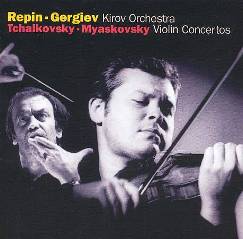Nikolay Myaskovsky – Cello Concerto-Violin Concerto
Nikolai Miaskovsky: Cello Concerto-Violin Concerto

Cello Concerto In C Minor, Op.66
1. Lento Ma Non Troppo
2. Allegro Vivace - Andante Semplice E Tranquillo - Tempo I - Lento Come Prima
Mstislav Rostropovich – cello
Royal Philharmonic Orchestra
Malcolm Sargent - conductor
Violin Concerto In D Minor, Op.44
1 - Allegro
2 - Adagio E Molto Cantabile
3 - Allegro Molto - Allegro Scherzoso
Vadim Repin – violin
Mariinsky Theatre Orchestra
Valery Gergiev – conductor
Myaskovsky's only cello concerto was written over the last three months of 1944 and dedicated to cellist Svyatoslav Knushevitsky. Despite being denounced, in 1948, along with fellow composers Prokofiev, Khachaturian, and Shostakovich, among others, for their "formalism" and "cosmopolitanism" over the previous decade and earlier, Myaskovsky was viewed quite favorably by the Soviet government and, as was the case with his Symphony No. 21 (1940), his Cello Concerto won the Stalin Prize.
The concerto, one of Myaskovsky's most gentle and lovely works, happens to share the same orchestral complement as the Piano Concerto No. 1 by Johannes Brahms -- pairs of woodwinds, four horns, two trumpets, timpani, and strings -- but has little of the dynamism and sense of titanic struggle of Brahms' concerto. If Myaskovsky is reflecting any of his own feelings about World War II in the cello concerto, they are feelings of sadness and eventual consolation, rather than of anger. The concerto is in two fairly lengthy movements, totaling just over half an hour. It begins with a restrained Lento, ma non troppo. The mournful opening melody, darkly colored by strings and bassoon, leads into the cello's entry. The flute and oboe gradually bring some lighter colors into the mix. Rather than stressing virtuosity, this opening movement employs the cello primarily as a melodic voice.
What little display the soloist is allowed comes in the short cadenza toward the end of the movement. The second movement, Allegro vivace, starts with a tarantella-like theme, to which the cello adds a second, folk song-like melody. These and other ideas are woven together and varied over the course of the movement's 20 minutes. After a cadenza for the soloist, a fanfare leads into a passionate restatement of the first movement's opening theme. The mournful tone of that opening movement returns for a time, but the work ends on a more peaceful note, resolving into a gentle C major. ---Chris Morrison, Rovi
Myaskovsky’s music has been criticized for its backward-looking nature and lack of great tunes. It is true that his music is steeped in the heart of 19th century romanticism, and there is little in his compositions that indicates he lived under the weight of the Soviet regime. However, there is sometimes a slight bow to 20th century aesthetics.
As for the "lack of great tunes" criticism, Myaskovsky’s three-movement Violin Concerto clearly puts that premise to rest. The abundance of memorable themes in this rapturous work is astounding, and the music flows beautifully throughout. Composed between March and June 1938, Myaskovsky dedicated the work to David Oistrakh who performed the premiere in Moscow on 10 January 1939. Being Myaskovsky’s first concerto, the results are all the more remarkable.
The 1st Movement Allegro is a 20-minute feast for the mind and heart replete with a 4-minute solo violin cadenza placed right in the middle of the movement. In the Introduction, Myaskovsky displays great strength and determination, giving way to the multi-faceted personality of the solo violin that takes us from tears and dismay to the heights of exhilaration. Although less than half the length of the 1st Movement, the 3rd Movement Allegro molto also contains a host of thematic material ranging from playful folk-dance numbers to pleadings of desperation. The central Movement Adagio molto cantabile is quite successful, but is limited in material compared to the outer movements. In any case, its primary theme is a lovely one of rapturous proportion.
Those of you who know Myaskovsky’s music through his symphonies will be surprised at the personal nature of the Violin Concerto. The symphonies were largely written for public consumption, but Myaskovsky clearly composed his Violin Concerto from the depth of his soul. ---Don Satz, www.musicweb-international.com
download: uploaded filecloudio yandex 4shared mediafire solidfiles mega
Last Updated (Sunday, 23 February 2014 14:25)








